Weekly Reports from Jordan
Choose Year: or Choose week
Impressions from Visitors
Summary by Douglas Clark, Director; Photographer, Jillian Logee unless otherwise indicated
A welcoming site, Tall al-`Umayri has hosted visitors and guests for millennia. Here are some of the people (etc.) who found their way to our home away from home this summer, for the most part:
Summer? Winter? Fourth century BC
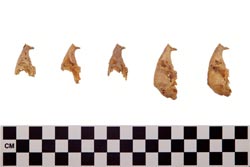 Five good-sized rodents (rats, perhaps, but palaeozoological analysis has yet to confirm this) paid a visit to `Umayri in the early Hellenistic period, finding an abundance of food stored in a large pithos (ceramic storage jar over one meter tall). We know this because these five were unable to escape the large jar due to its depth. They may have been happy for a time, but clearly their fortunes changed. The skulls will be tested for any indications of cannibalism. All of this provides graphic illustration of the intense competition for scarce food resources in the ancient world – humans, domesticated animals, replanting supplies for future well being, vermin and varmints, bugs, mildew, and rot. For ancient farmers to toil for months for at times meager agricultural returns, only to see a large percentage disappear, added to the plight of our forebears and provides a graphic reminder about the importance of survival strategies.
Five good-sized rodents (rats, perhaps, but palaeozoological analysis has yet to confirm this) paid a visit to `Umayri in the early Hellenistic period, finding an abundance of food stored in a large pithos (ceramic storage jar over one meter tall). We know this because these five were unable to escape the large jar due to its depth. They may have been happy for a time, but clearly their fortunes changed. The skulls will be tested for any indications of cannibalism. All of this provides graphic illustration of the intense competition for scarce food resources in the ancient world – humans, domesticated animals, replanting supplies for future well being, vermin and varmints, bugs, mildew, and rot. For ancient farmers to toil for months for at times meager agricultural returns, only to see a large percentage disappear, added to the plight of our forebears and provides a graphic reminder about the importance of survival strategies.
3 July, 2012
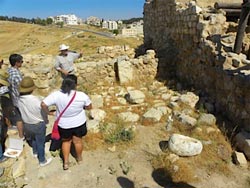 Dr. Bailey Gillespie, La Sierra University, brought a small group of students and others to the site as part of their Middle Eastern tour of Israel, Palestine and Jordan. Joining them were Dr. Murray Brandstater (a part of the 2012 excavation team), his sister Lynne Bellville, and her friend, Mary Aqleh. Forty-five minutes gave us time for only a quick introduction of the site, but also provided a feel for real dirt archaeology.
Dr. Bailey Gillespie, La Sierra University, brought a small group of students and others to the site as part of their Middle Eastern tour of Israel, Palestine and Jordan. Joining them were Dr. Murray Brandstater (a part of the 2012 excavation team), his sister Lynne Bellville, and her friend, Mary Aqleh. Forty-five minutes gave us time for only a quick introduction of the site, but also provided a feel for real dirt archaeology.
July-August 2012
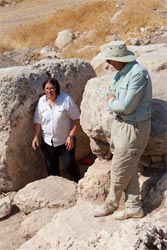
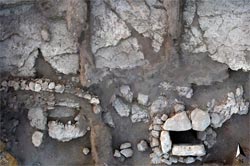 Dr. Ela Dubis, former (and forever) member of the `Umayri team who is not excavating this summer, but who is completing her research on the 5,000-year-old dolmen tomb she unearthed over the course of several past seasons. In the process of her cleaning for digital photography (photographic boom and gigapan 3-D recording) and checking out results of the boom photography, Ela is now convinced that there are foundation stones for a second dolmen immediately to the west of the first. At this point we will try to collaborate with the Hashemite University geoarchaeology team under the direction of Bilal Khrisat to do some sub-surface mapping for any other dolmen remains.
Dr. Ela Dubis, former (and forever) member of the `Umayri team who is not excavating this summer, but who is completing her research on the 5,000-year-old dolmen tomb she unearthed over the course of several past seasons. In the process of her cleaning for digital photography (photographic boom and gigapan 3-D recording) and checking out results of the boom photography, Ela is now convinced that there are foundation stones for a second dolmen immediately to the west of the first. At this point we will try to collaborate with the Hashemite University geoarchaeology team under the direction of Bilal Khrisat to do some sub-surface mapping for any other dolmen remains.
11 July 2012
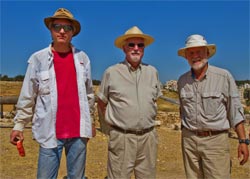 Dr. William Dever (emeritus professor University of Arizona), Dr. Neal Bierling (Calvin College) and Ray Willey (California), to see progress on the excavations. Bill Dever is a long-time friend of the project and periodically checks up on us, providing enlightenment and entertainment in the process. Several of his doctoral students are part of the larger Madaba Plains Project orbit, and it’s always a treat to have him on site.
Dr. William Dever (emeritus professor University of Arizona), Dr. Neal Bierling (Calvin College) and Ray Willey (California), to see progress on the excavations. Bill Dever is a long-time friend of the project and periodically checks up on us, providing enlightenment and entertainment in the process. Several of his doctoral students are part of the larger Madaba Plains Project orbit, and it’s always a treat to have him on site.
11 July 2012
Dr. Eva Andersson from the Danish National Research Foundation’s Centre for Textile Research, SAXO-institute, and a member of the Wadi Thamad excavation team southeast of Madaba, expressed interest in a collaborative effort to sponsor a conference in Amman in November 2013 on ancient textiles production. Our own Mary Boyd, who does our textiles analyses, was part of the conversation.
13 July 2012
Dr. Bilal Khrisat and Dr. Abdulraouf Mayyas from the Department of Conservation Sciences in the Queen Rania Institute of Tourism and Heritage at Hashemite University in Zarqa, north of Amman, who stopped by to explore possibilities of collaboration in the study of residues left behind in ancient pottery vessels and geoarchaeology. The two-year project, titled "Analysis of Organic Residues Preserved in Archaeological Ceramics from Bronze Age and Iron Age Sites in Jordan," is funded by the Scientific Research Support Fund/The Ministry of Higher Education and Scientific Research of Jordan. We have already collected several samples for residue analysis and will be seeking help with subsurface mapping around the dolmen, as it appears that the foundations for a second dolmen have emerged nearby.
18-25 July 2012
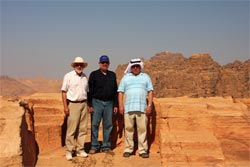
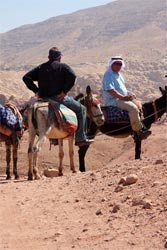 Dr. Larry Geraty, Founding Director of the Madaba Plains Project-`Umayri and President Emeritus at La Sierra University, and Norman Yergen, Vice President for Advancement at La Sierra University, came to see how we are doing and to visit friends in Jordan and partners in Jerusalem.
Dr. Larry Geraty, Founding Director of the Madaba Plains Project-`Umayri and President Emeritus at La Sierra University, and Norman Yergen, Vice President for Advancement at La Sierra University, came to see how we are doing and to visit friends in Jordan and partners in Jerusalem.
19 July 2012
Accompanying Larry Geraty and Norman Yergen, Dr. Andy Vaughn, Executive Director of the American Schools of Oriental Research (ASOR) in Boston, and his daughter Orly are here to visit Amanda Hopkins, one of this year’s recipients of an ASOR award to help with excavation expenses on an ASOR-accredited excavation – MPP-`Umayri.
1-3 August 2012
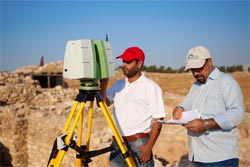 Qutaiba Dasouqi, Jamal Safi, and Tawfiq Al Hunaiti from the Department of Antiquities, bringing with them a Leica LiDar laser scanner (ca. $100,000 in value), spent two days at the site laser-scanning the Late Bronze Age temple, the Early Iron I four-room house and neighboring buildings, as well as the emerging Early Iron I building in Field H, all in an effort to record for posterity, with definition down to a few millimeters, all the features of these buildings. Results can be used for accurate reconstruction and visualization in 3-D “cave” viewing environments, like the one we hope to construct in the new La Sierra archaeology museum (insha`allah).
Qutaiba Dasouqi, Jamal Safi, and Tawfiq Al Hunaiti from the Department of Antiquities, bringing with them a Leica LiDar laser scanner (ca. $100,000 in value), spent two days at the site laser-scanning the Late Bronze Age temple, the Early Iron I four-room house and neighboring buildings, as well as the emerging Early Iron I building in Field H, all in an effort to record for posterity, with definition down to a few millimeters, all the features of these buildings. Results can be used for accurate reconstruction and visualization in 3-D “cave” viewing environments, like the one we hope to construct in the new La Sierra archaeology museum (insha`allah).
2 August 2012
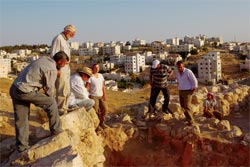 Ahmad Ash-Shami, twice the DoA representative for `Umayri, as well as excavator of the Byzantine Church on what we call “`Umayri East” because of its location across the Airport Highway from `Umayri, made his regular, annual visit to the site. He always brings with him new ideas and new questions in his quest to piece together Jordan’s rich archaeological fabric.
Ahmad Ash-Shami, twice the DoA representative for `Umayri, as well as excavator of the Byzantine Church on what we call “`Umayri East” because of its location across the Airport Highway from `Umayri, made his regular, annual visit to the site. He always brings with him new ideas and new questions in his quest to piece together Jordan’s rich archaeological fabric.
5 August 2012
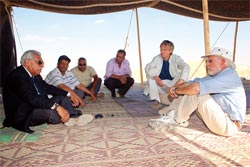 Today saw three-plus important visitors, along with an entourage of photographer and specialists, come to the site accompanied by Doug Clark, Kent Bramlett, and our DoA representatives, Abdelrahim Al-Dwikat and Adnan Rafaiah: His Excellency Mr. Nayef Hmeidi Al Fayez, Minister of Tourism and Antiquities, His Excellency Mr. Akel Biltaji, senator and former Minister of Tourism and Antiquities (who knows the site well and has worked with our team in the past), and Mr. Fares Hmoud, Acting Director General of the Department of Antiquities. It was an extremely informative visit for everyone, and we hope will lead to solving the issues of land ownership at `Umayri.
Today saw three-plus important visitors, along with an entourage of photographer and specialists, come to the site accompanied by Doug Clark, Kent Bramlett, and our DoA representatives, Abdelrahim Al-Dwikat and Adnan Rafaiah: His Excellency Mr. Nayef Hmeidi Al Fayez, Minister of Tourism and Antiquities, His Excellency Mr. Akel Biltaji, senator and former Minister of Tourism and Antiquities (who knows the site well and has worked with our team in the past), and Mr. Fares Hmoud, Acting Director General of the Department of Antiquities. It was an extremely informative visit for everyone, and we hope will lead to solving the issues of land ownership at `Umayri.
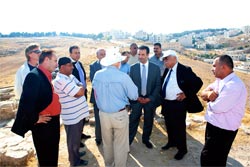 |
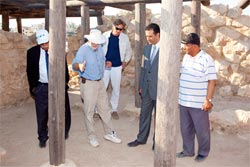 |
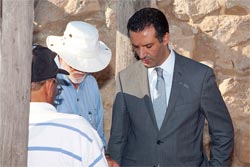 |
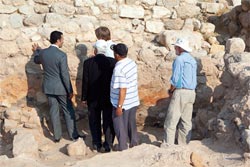 |
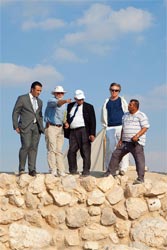 |
 |
